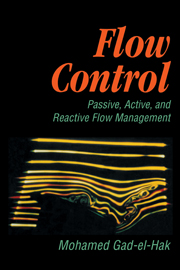Book contents
- Frontmatter
- Contents
- Preface
- Nomenclature
- 1 Introduction
- 2 Governing Equations
- 3 Unifying Principles
- 4 Coherent Structures
- 5 Reynolds Number Effects
- 6 Transition Control
- 7 Compliant Coatings
- 8 Separation Control
- 9 Low-Reynolds-Number Aerodynamics
- 10 Drag Reduction
- 11 Mixing Enhancement
- 12 Noise Reduction
- 13 Microelectromechanical Systems
- 14 Frontiers of Flow Control
- Epilogue
- Bibliography
- Index
11 - Mixing Enhancement
Published online by Cambridge University Press: 23 December 2009
- Frontmatter
- Contents
- Preface
- Nomenclature
- 1 Introduction
- 2 Governing Equations
- 3 Unifying Principles
- 4 Coherent Structures
- 5 Reynolds Number Effects
- 6 Transition Control
- 7 Compliant Coatings
- 8 Separation Control
- 9 Low-Reynolds-Number Aerodynamics
- 10 Drag Reduction
- 11 Mixing Enhancement
- 12 Noise Reduction
- 13 Microelectromechanical Systems
- 14 Frontiers of Flow Control
- Epilogue
- Bibliography
- Index
Summary
Now I think hydrodynamics is to be the root of all physical science, and is at present second to none in the beauty of its mathematics.
(William Thomson (Lord Kelvin), 1824–1907)I pass with relief from the tossing sea of Cause and Theory to the firm ground of Result and Fact.
(Sir Winston Leonard Spencer Churchill, 1874–1965, in The Malakand Field Force)PROLOGUE
This chapter deals with the enhancement of rates of mass, momentum, and heat transfer. This is desired to improve the performance of mixers of nonreacting species; chemical reactors, including combustors; lifting surfaces; heat exchangers, including those in HVAC systems; and numerous other man-made devices. In nature, the efficient turbulence mixing is responsible for the nearly uniform distribution of oxygen, carbon dioxide, and internal energy in the Earth's atmosphere and oceans. Without that more-or-less uniform distribution, seasonal and latitudinal temperature changes would be even more extreme. Oxygen would be more concentrated in the equatorial rain forests, and carbon dioxide would be more concentrated in industrial and urban centers. Under such circumstances, city dwellers at least would not survive long on this third planet from the sun. In plants and animals, the efficient transport of mass and energy through limited spaces is also vital for their survival. The subject of mixing enhancement is very broad, is important to entire industries, and is covered extensively in many journals and books.
- Type
- Chapter
- Information
- Flow ControlPassive, Active, and Reactive Flow Management, pp. 229 - 249Publisher: Cambridge University PressPrint publication year: 2000
- 1
- Cited by

